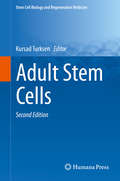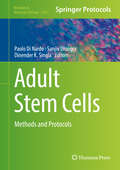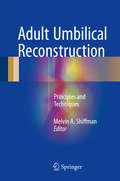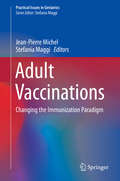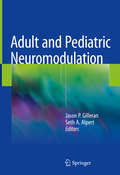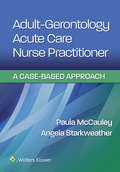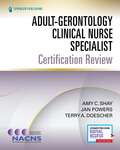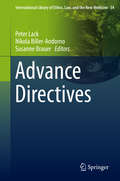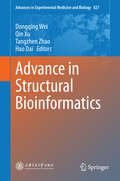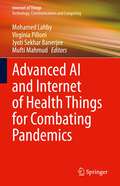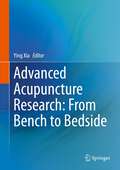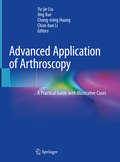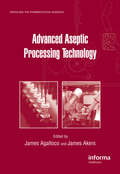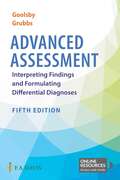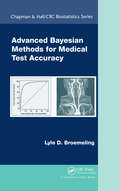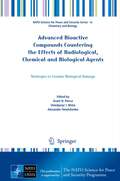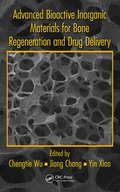- Table View
- List View
Adult Stem Cells (Stem Cell Biology and Regenerative Medicine)
by Kursad TurksenAdult Stem Cells, second edition, takes a critical look at issues concerning the developmental or differentiation potential for a variety of tissue types and for specific adult stem cell types. Since the first edition appeared a decade ago, our understanding of adult stem cells, and more specifically tissue-specific adult stem cells, has advanced tremendously. And an increased interest in regenerative medicine and potential stem cell applications has driven a quest for better understanding of stem cell biology. In turn, this has spawned much activity on generation and utilization of more and better reagents to identify and isolate stem cells and stem cell-like subpopulations, and on assays elucidating their developmental or differentiation potential and functional integration with host tissues and organs. In this fully updated new edition, chapters cover topics ranging from signaling pathways maintaining stemness in hematopoietic cells to regeneration after injury and endocrine mechanisms underlying the stem cell theory of aging. Other chapters cover stem cells by organ or system including pituitary, cardiac, epithelial, teeth, lung, ovary, prostate, liver, and many more. Importantly, the authors of the chapters have not only summarized their successes, but have also summarized some of the difficulties that each particular field is still facing with respect to maximizing the utility of stem cells in clinical settings. Collectively, they impart both the excitement and challenges facing stem cell utilization for repair and regeneration making this book essential reading for those involved in stem cell research as well as those involved in clinical assays.
Adult Stem Cells: Methods and Protocols (Methods in Molecular Biology #1553)
by Paolo Di Nardo Sanjiv Dhingra Dinender K. SinglaStem cell research and technology represent a major challenge for treating otherwise non-curable patients. A decade of intensive research has demonstrated that initial hopes based more on the will to succeed than on solid scientific bases can be translated into factual techniques only by adopting more rigorous procedures and strategies. Among other major impediments, the failure so far experienced in applying stem cell technologies to repair parenchymal organs can be ascribed to the lack of sufficient knowledge of basic mechanisms but also to the lack of standardized criteria and protocols. Each laboratory often follows its own "recipe," using erratic nomenclature and non-comparable, if not confusing, experimental protocols. All of this makes it difficult to learn from the others and, ultimately, hampers the advancement of knowledge on stem cell behavior. The ambitious goal of this book is to gather the most innovative and scientifically robust knowledge and technologies on stem cells and to involve investigators from academies and industries in order to formulate recommendations that could standardize the isolation and manipulation of stem cells using solid and well-documented knowledge rather than fragmentary and often unrepeatable experimental reports.
Adult T-cell Leukemia/Lymphoma
by Toshiki Watanabe Takuya FukushimaThis book provides essential information on the epidemiology, molecular and genetic features, anti-CCR4 antibody therapy and a nationwide study of transplantation on human T-leukemia virus type-I (HTLV-1) and adult T-cell leukemia/lymphoma (ATL). This rare but important disease has restricted endemic areas and distinct clinical features such as a high frequency of hypercalcemia, strong predisposition to infection and poor response to chemotherapy, aspects which set ATL apart from other types of non-Hodgkin lymphoma. Given the small number of patients, enrollment in clinical trials has not been feasible, and establishing treatment standard has been difficult but new evidence, such as results of nationwide studies on transplantation, have shown new insights and potential treatments. Based on recent evidence, the book presents new treatment methods for ATL and infection prevention of HTLV-1, enabling clinicians, researchers and post-docs specializing in hematology and virology to gain a valuable overview of the disease.
Adult Umbilical Reconstruction: Principles and Techniques
by Melvin A. ShiffmanThis book starts with a description of the anatomy of the umbilicus and its ideal shape. After a brief summary of the history of umbilical reconstruction, currently used umbilical reconstructive techniques are presented. The reader will also find information on the reconstruction of the umbilicus after malignant melanoma; outcomes and complications will be discussed in the last chapters. Written by respected authors, this book will offer residents and fellows as well as practicing and highly experienced plastic surgeons essential guidance on treatment and decision-making concerning umbilical reconstruction. Its numerous illustrations and clearly structured content make the book a must-read. Written by respected expertsProvides a clear overview of the surgical techniques currently used for umbilical reconstructionAddresses beginners and experienced surgeons in the fields of plastic surgery, general surgery, cosmetic surgery and breast surgery
Adult Vaccinations: Changing the Immunization Paradigm (Practical Issues in Geriatrics)
by Jean-Pierre Michel Stefania MaggiAfter introductory chapters devoted to the safe production and distribution of vaccines, the book addresses the question of adult vaccination in the framework of a life-course approach to vaccination. It presents the proceedings of multidisciplinary expert discussions with an excellent summary of the current state of knowledge on adult vaccination in various diseases, as well as an overview of the professionals involved and the obstacles to achieving greater vaccine uptake, and how these may be addressed.The book systematically discusses the major vaccine-preventable diseases, as well as regulatory issues in vaccine provision, and presents the results of an expert meeting designed to identify the obstacles to vaccination, and solutions for addressing these barriers. It goes on to extend the discussion beyond the traditional boundaries of human health to encompass the “one health” concept.The book is intended for all those with an interest in vaccination, including physicians (from a wide range of disciplines including geriatrics/gerontology, infectious diseases, pediatrics, internal medicine, and other non-organ specialties), other healthcare professionals, pharmacists, representatives of the pharmaceutical industry and regulatory bodies (EMEA, national authorities), policymakers, the media and the general public.
Adult and Paediatric Als
by Charles D. DeakinCompetency in resuscitation is a necessity for most clinical staff, with many attending Advanced Life Support (ALS) courses. Adult and Paediatric ALS: Self-assessment in Resuscitation uses an innovative question-and-answer structure and Resuscitation Council (UK) 2010 Guidelines to provide a complete overview of all aspects of advanced life support and resuscitation in adults and children. Comprising ten chapters of multiple choice questions, diagnostic questions, colour photo questions and comprehensive answers, this resource aids revision of the adult and paediatric ALS syllabus and assists readers in gaining a thorough understanding of all aspects of resuscitation science and practice. Written by a leading resuscitation expert, Adult and Paediatric ALS: Self-assessment in Resuscitation is essential reading for anyone undertaking resuscitation training, beginning training in acute resuscitation specialities or wishing to update their knowledge of advanced life support.
Adult and Pediatric Neuromodulation
by Jason P. Gilleran Seth A. AlpertThis text reviews the anatomy and physiology of neuromodulation for treatment of various pathology of the human body, with specific emphasis on sacral neuromodulation for bladder and bowel dysfunction in the adult and pediatric populations. <P><P>In addition to historical overview of the various methods of neuromodulation, present day applications will be discussed as well as possible future directions for use. Adult and Pediatric Neuromodulation will be of great value to medical professionals who are interested in the use of neuromodulation as a possible therapy option for their patients, particularly when other traditional or medical management options have failed. Each chapter is written by experts in the topic of various modalities of neuromodulation.
Adult and Pluripotent Stem Cells: Potential for Regenerative Medicine of the Cardiovascular System
by Jürgen Hescheler Erhard HoferThere is hardly an area of research developing so quickly and raising so many promises as stem cell research. Adult, embryonic and recently available induced pluripotent stem cells not only foster our understanding of differentiation of endo-, ecto- and mesodermal lineages to all organs of the body, but foremost nourish the hope that cells grown in culture can be used for regeneration of diseased organs such as the heart damaged by myocardial infarction. This book focuses on perspectives of stem cells for regenerative therapy of cardiovascular diseases. Based on the EC consortium INELPY, it reviews the field and disseminates major outcomes of this project. Thus it introduces the reader to this fascinating area of research and incorporates very recent findings interesting to the expert, spanning the field from bench to bedside. The compilation of contributions is unique as there is yet no similar comprehensive overview combining stem cell research with preclinical and clinical evaluation as well as engineering of tissue patches for transplantation. As such it will be an invaluable source of information for all researchers in the stem cell and tissue regeneration field including bioengineers as well as for all clinicians interested in regenerative therapies, especially for ischemic cardiomyopathies.
Adult-Gerontology Acute Care Nurse Practitioner: A Case-Based Approach
by Paula McCauleyAdult-Gerontology Acute Care Nurse Practitioner: A Case-Based Approach Studying for AGACNP/DNP certification, or looking to strengthen your adult-gerontology acute care skills? Grab the know-how, support, and practical guidance you need, with Adult-Gerontology Acute Care Nurse Practitioner. This clearly written, evidenced-based guide offers best practices for providing patient- and family-centered care for young adults, older adults, and elderly patients facing complex acute and/or chronic health conditions. From foundational advanced practice knowledge and skills to informed clinical judgment, this is an indispensable reference for preparing for AGACNP/DNP certification, and a clinical road map for all adult-gerontology acute care nurse practitioners.
Adult-Gerontology Clinical Nurse Specialist Certification Review
by Amy C. Shay Jan Powers Terry A. DoescherAdulteration in Herbal Drugs: A Burning Issue
by Mushtaq Ahmad Shabnum Shaheen Sehrish Ramzan Farah KhanSubstitution and adulteration in traded herbal raw material are common practice in the herbal industry due to the extinction of required species, deforestation and incorrect taxonomical identification. Herbalists have adopted methods to create high quality adulteration which cannot be detected without performing microscopic examination or chemical analysis. It is difficult to establish specific quality control standards due to the complex nature and innate unpredictability of the chemical constituents of medicinal herbs.The main parameters for measurement and adulteration prevention in medicinal herbs are morphological and microscopic investigation, chemical profiling and DNA barcoding. The need for highly sensitive and more effective approaches for the authentication of medicinal herbs is necessary in order to promote the acceptance of herbal products. Adulteration In Traditional Medicinal Herbs is aimed at promoting awareness of adulteration in traditional herbal medicines for the worldwide scientific community. Parameters are established for the prevention of adulteration through classical and modern scientific tools. Valuable case studies are presented based on ethno-medicinal surveys performed in many herbal markets in Pakistan. Collections of various samples were obtained from these shops then compared with the original plants collected from field. Various phytochemical, organoleptic and DNA barcoding techniques were used in order to detect adulteration in the marketed herbal samples. This book is the first of its kind and is aimed at helping the scientific community to identify particular medicinal plants which are facing adulteration problems in herbal markets and to estimate the extent of adulteration and substitution in commonly used medicinal herbs.
Advance Directives (International Library of Ethics, Law, and the New Medicine #54)
by Peter Lack Nikola Biller-Andorno Susanne BrauerThis volume gives an overview on the currently debated ethical issues regarding advance directives from an international perspective. It focuses on a wider understanding of the known and widely accepted concept of patient self-determination for future situations. Although advance directives have been widely discussed since the 1980s, the ethical bases of advance directives still remain a matter of heated debates. The book aims to contribute to these controversial debates by integrating fundamental ethical issues on advance directives with practical matters of their implementation. Cultural, national and professional differences in how advance directives are understood by health care professions and by patients, as well as in laws and regulations, are pinpointed.
Advance in Structural Bioinformatics (Advances in Experimental Medicine and Biology #827)
by Dongqing Wei Qin Xu Tangzhen Zhao Hao DaiThis text examines in detail mathematical and physical modeling, computational methods and systems for obtaining and analyzing biological structures, using pioneering research cases as examples. As such, it emphasizes programming and problem-solving skills. It provides information on structure bioinformatics at various levels, with individual chapters covering introductory to advanced aspects, from fundamental methods and guidelines on acquiring and analyzing genomics and proteomics sequences, the structures of protein, DNA and RNA, to the basics of physical simulations and methods for conformation searches. This book will be of immense value to researchers and students in the fields of bioinformatics, computational biology and chemistry. Dr. Dongqing Wei is a Professor at the Department of Bioinformatics and Biostatistics, College of Life Science and Biotechnology, Shanghai Jiaotong University, Shanghai, China. His research interest is in the general area of structural bioinformatics.
Advanced AI Techniques and Applications in Bioinformatics (Smart and Intelligent Computing in Engineering)
by Loveleen Gaur, Arun Solanki, Samuel Fosso Wamba and Noor Zaman JhanjhiThe advanced AI techniques are essential for resolving various problematic aspects emerging in the field of bioinformatics. This book covers the recent approaches in artificial intelligence and machine learning methods and their applications in Genome and Gene editing, cancer drug discovery classification, and the protein folding algorithms among others. Deep learning, which is widely used in image processing, is also applicable in bioinformatics as one of the most popular artificial intelligence approaches. The wide range of applications discussed in this book are an indispensable resource for computer scientists, engineers, biologists, mathematicians, physicians, and medical informaticists. Features: Focusses on the cross-disciplinary relation between computer science and biology and the role of machine learning methods in resolving complex problems in bioinformatics Provides a comprehensive and balanced blend of topics and applications using various advanced algorithms Presents cutting-edge research methodologies in the area of AI methods when applied to bioinformatics and innovative solutions Discusses the AI/ML techniques, their use, and their potential for use in common and future bioinformatics applications Includes recent achievements in AI and bioinformatics contributed by a global team of researchers
Advanced AI and Internet of Health Things for Combating Pandemics (Internet of Things)
by Mufti Mahmud Mohamed Lahby Jyoti Sekhar Banerjee Virginia PilloniThis book presents the latest research, theoretical methods, and novel applications in the field of Health 5.0. The authors focus on combating COVID-19 or other pandemics through facilitating various technological services. The authors discuss new models, practical solutions, and technological advances related to detecting and analyzing COVID-19 or other pandemic based on machine intelligence models and communication technologies. The aim of the coverage is to help decision-makers, managers, professionals, and researchers design new paradigms considering the unique opportunities associated with computational intelligence and Internet of Medical Things (IoMT). This book emphasizes the need to analyze all the information through studies and research carried out in the field of computational intelligence, communication networks, and presents the best solutions to combat COVID and other pandemics.
Advanced Acupuncture Research: From Bench to Bedside
by Ying XiaWritten by over seventy scientists and clinicians worldwide from China, USA, Germany, Canada, Japan and other countries, this monograph, with nearly 450 figures and tables, covers a wide range of advanced progress in acupuncture research, from experimental research to clinical applications. In addition to exploring the histopathological basis for acupuncture and mathematical simulation of acupoint response to stimulation, initiation and transduction of acupuncture signals and cellular mechanisms during acupuncture effects as well as chemical and physical characteristics of moxibustion on acupoints are broadly discussed. The topics also include novel data on acupuncture effect with advanced imaging techniques, a unique understanding of meridian-viscera correlation, specific interactions between meridians and neurosensory organs within the system of homeostatic regulation and the acupuncture-induced influences on autonomic function. Several chapters introduce specific approaches with dry needling, silver needling and stainless needling for certain diseases, such as myofascitis, supportive care for breast cancer and chemotherapy-induced peripheral neuropathy as well as perioperative care of surgical patients. Moreover, this book discusses recent research on acupuncture therapy and potential mechanisms for a number of severe and refractory neurological disorders, including hyperactivity of hypothalamic-pituitary-adrenal axis, orofacial pain, chronic pain, itch, multiple sclerosis, autism spectrum disorders, cerebral palsy, depressive disorders, Alzheimer’s disease and ischemic brain injury. The vast amount of information offered in this book provides a comprehensive perspective on advanced acupuncture research to not only acupuncturists, but also to neuroscientists, neurologists, and other clinicians. For medical students and graduate and undergraduate students majoring in biology, physiology and neuroscience, this book offers an advanced course in learning about the mechanism-driven advances in alternative and complementary medicine.
Advanced Aesthetic Rhinoplasty: Art, Science, and New Clinical Techniques
by Melvin A. Shiffman Alberto Di GiuseppeAesthetic rhinoplasty is among the most common aesthetic operations in the field of facial aesthetic plastic surgery, but it is also viewed as one of the most complex. This comprehensive book provides a wealth of up-to-date information on advanced aesthetic rhinoplasty techniques. After discussion of anatomy, psychological issues, and preoperative planning, a wide range of primary and secondary rhinoplasty techniques are described clearly and in detail with the aid of numerous high-quality color illustrations. The use of fillers in rhinoplasty, ethnic variations in anatomy and techniques, and possible risks and complications are all clearly explained. This book is intended primarily for experienced surgeons in the fields of plastic surgery, cosmetic surgery, general surgery, otolaryngology, ophthalmology, oral maxillofacial surgery, and cosmetic surgical subspecialties. It will also be an invaluable resource for residents and fellows.
Advanced Age Geriatric Care: A Comprehensive Guide
by Nages Nagaratnam Kujan Nagaratnam Gary CheukAs the Baby Boomers age, concerns over healthcare systems' abilities to accommodate geriatric patients grow increasingly challenging. This is especially true with the population deemed to be “the oldest of the old,” specifically those over the age of 85. Unlike any other time in history, this demographic is the fastest growing segment of most developed countries. In the United States the oldest old is projected to double from 4.3 million to 9.6 million by 2030. The increased life expectancy of the population since the early 1900s has been built on the improvement of living conditions, diet, public health and advancement in medical care. With this we have seen a steady decline in the age-specific prevalence of vascular and heart diseases, stroke and even dementia. Older persons are healthier today than their counterparts decades ago. More importantly than in any other age group, the care of the oldest old must be individualized; management decisions should be made taking into consideration the older persons’ expressed wishes, quality of life, function and mental capacity. The inevitable consequence is that there will be an increase in the prevalence of older persons with chronic diseases, multiple co-existing pathologies and neuro-degenerative diseases. The oldest of the aging population are often excluded from drug trials and their treatments are largely based on findings extrapolated from that of the younger old. Furthermore, among the oldest old, physiologically they are more diverse than other segments of the population. Their demographic characteristics are unparalleled and different compared to that of the younger old. Several studies have drawn attention to the differing attitudes among health professionals towards elderly people and many show prejudice because they are old. As a result, the use of age as a criteria in determining the appropriateness of treatment is of very limited validity, yet there are limited resources that guide physicians through these challenges. This book creates a greater awareness of these challenges and offers practical guidelines for working within the infrastructures vital to this demographic. This book is designed for geriatricians, primary care physicians, junior medical officers, specialty geriatrics nurses, and gerontologists. It is divided into 3 sections: General Considerations, Chronic diseases and Geriatric Syndromes. Each chapter provides a summary of important and essential information under the heading of Key Points. Case studies are included in some of the chapters to highlight the principles of management.
Advanced Application of Arthroscopy: A Practical Guide with Illustrative Cases
by Chang-Ming Huang Yu-Jie Liu Jing Xue Chun-Bao LiThis book provides arthroscopy techniques and applications to clinical practitioners, including sports medicine therapeutics, orthopaedic surgeons, specialist training candidates, rehabilitation clinicians. It also includes small incisions per minimally invasive surgery using a camera mounted on a thin tube to visualize, repair and reconstruct joint-associated structures. Arthroscopy technique as a minimally invasive surgical method, in Orthopeadics is not only for the treatment of intra-articular diseases but also an advanced conception for treatment of extra-articular diseases and peri-articular fractures. After performing years of arthroscopy, authors intend to provide an elite technique demonstration of each procedure, including indications, technique, complications, and results. There are three main parts of the book, including the extra-articular application of arthroscopy techniques, arthroscopic minimally invasive techniques for the treatment of intra-articular fractures, and Innovative technology for repair and reconstruction of bone and joint injuries. Key technical points and experience of arthroscopic repair of joint injuries, dislocation of joints, fixation of the intra-articular fractures, ligament release for limbs are illustrated. Special situations such as congenital torticollis, deltoid contracture, gluteal muscle contracture, bone grafting, removal of locking plate and screw and benign tumors treatment are also included.
Advanced Aseptic Processing Technology (Drugs and the Pharmaceutical Sciences)
by James Agalloco James AkersThe preparation of sterile products using aseptic processing is considered perhaps the most critical process in the pharmaceutical industry and has witnessed continual improvement over the last half century. New approaches that have transformed classical aseptic production methods are appearing almost daily. This book reviews emerging technologies
Advanced Assessment: Interpreting Findings And Formulating Differential Diagnoses
by Mary Jo Goolsby Laurie GrubbsYour essential guide in the assessment and diagnostic process. Step by step, you’ll hone your ability to perform effective health assessments, obtain valid data, interpret the findings, and recognize the range of conditions that can be indicated by specific findings to reach an accurate differential diagnosis. You’ll have coverage of 170 conditions and symptoms across the lifespan at your fingertips.
Advanced Bayesian Methods for Medical Test Accuracy (Chapman & Hall/CRC Biostatistics Series)
by Lyle D. BroemelingUseful in many areas of medicine and biology, Bayesian methods are particularly attractive tools for the design of clinical trials and diagnostic tests, which are based on established information, usually from related previous studies. Advanced Bayesian Methods for Medical Test Accuracy begins with a review of the usual measures such as specificity
Advanced Bioactive Compounds Countering the Effects of Radiological, Chemical and Biological Agents: Strategies to Counter Biological Damage (NATO Science for Peace and Security Series A: Chemistry and Biology)
by Volodymyr I. Mizin Alexander Omelchenko Grant N. PierceThe probability for exposure to damaging radiation, toxic chemicals in the environment and adverse biological agents has increased exponentially today. The more frequent and faster travel that we experience today also escalates the risk of contraction and transmission of potentially deadly infections. This has created a very real and escalating risk for injuries and deaths. This is accentuated in the military and medical staff that is more frequently exposed to radiological, chemical, and biological agents in their normal working environment. Understanding the mechanisms whereby these toxic agents inflict damage to our bodies is essential to prepare us for these challenges. Much of the damage is inflicted through the generation of free radicals and non-radical oxidants which then act through oxidative mechanisms to injury the body. This volume will discuss the damage caused by these radiological, chemical, and biological environmental stressors, the mechanisms through which the damage can occur and the novel strategies that can be used to reduce the injury inflicted by these toxic compounds. Using basic and clinical research approaches, the contents of this book discuss new ideas for the development of bioactive products and environmental approaches to lessen or negate the biological damage inflicted by these noxious compounds.
Advanced Bioactive Inorganic Materials for Bone Regeneration and Drug Delivery
by Chengtie Wu Jiang Chang Yin XiaoBioceramics play an important role in repairing and regenerating defective or damaged bone. This volume reviews the latest advances in the field. Offering guidance for biomedical engineering researchers and material scientists, the book summarizes innovative concepts, bioceramic design, and methods for material synthesis and drug delivery. It covers design and fabrication of these materials, down to the nanoscale, and includes chapters on medical device engineering using these materials. The book is designed to enhance study and career development for those in this field and to facilitate further research and opportunities for new solutions.
Advanced Bioceramics: Properties, Processing, and Applications
by Kheng Lim Goh Md Enamul Hoque Suresh SagadevanAdvanced Bioceramics: Properties, Processing, and Applications describes development of bioceramics and biocomposites, which are used in various biomedical applications including bone tissue repair, remodelling and regeneration. It covers the fundamental aspects of materials science and bioengineering, clinical performance in a variety of applications, ISO/ASTM specifications, and opportunities and challenges. • Offers a comprehensive view of properties and processing of bioceramics. • Highlights applications in dentistry, orthopaedic and maxillofacial implants, and regenerative and tissue engineering. • Covers ISO/ASTM specifications such as processing, clinical applications, recycling/reuse and disposal standards. • Explores health, environmental and ethical issues. With contributions from eminent editors and recognized authors around the world, this book should serve as an important reference for academics, scientists, researchers, students and practitioners in materials science and biomedical engineering. It is to assist in the design of novel, targeted and personalised bioceramic-based solutions to advanced healthcare.
